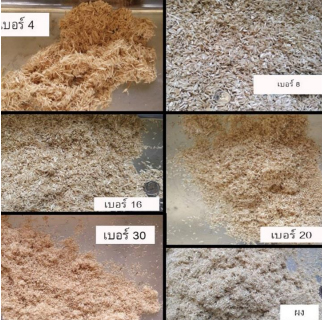The Development of Interior Wall Panel from Hemp Woody Core
Main Article Content
Abstract
This research is focused on the study of how to develop interior wall panel from hemp woody core. Three types of adhesives; Urea-formaldehyde adhesive (UF) , Isocyanate- based adhesive ( E- Zero) and Shellac ( lac) were mixed with hemp material to create sample hemp boards using hydraulic hot press machine. The physical and mechanical properties of the panels: density, moisture content, percentage of swelling, modulus of rupture and elasticity, and internal bond strength were determined according to the specifications of Thai Industrial Standard (TIS) 876 – 2547) Then, thermal insulation properties of the boards were tested. Results indicated that hemp board with shellac adhesive meet most of the requirements as per Thailand industrial Standard specification. Some of the properties i.e. density, moisture content, and internal bond of hemp boards with all three types of adhesives were found higher than the required value of Thailand Standard specification ( 876 – 2547) . Test results on thermal and physical properties
showed that the hemp boards with UF and E-Zero binding exhibited a considerably good thermal insulation.
Article Details

This work is licensed under a Creative Commons Attribution-NonCommercial-NoDerivatives 4.0 International License.
References
บุญศักดิ์ สมบุญรอด และคณะ, “การผลิตแผ่นไม้ปาร์ติเกิลเสริมแรงจากแกนต้นกัญชง” ,รายงานผลการวิจัย ประจำปี 2549, สำนักวิจัยการจัดการป่าไม้และผลิตผลป่าไม้, 2549.
ภัสสร กลิ่นรอด. (2015). “แผ่นผนังและฝ้าเพดานภายในอาคารจากเส้นใยและแกนลำต้นกัญชง”. วิทยานิพนธ์ปริญญาโท, มหาวิทยาลัยเกษตรศาสตร์.
H. Kallakas, “Mechanical and physical properties of industrial hemp-based insulation materials”. Proceedings of the Estonian Academy of Sciences, 2018, 67, 2, 183–192.
E. Kirilovs, S. Kukle, and H. J. Gusovius, “Wet-preserved hemp fibreboard properties improvement with veneering”, 4th International Congress in Advances in Applied Physics and Materials Science (APMAS 2014), AIP Conf. Proc. 1653, 020059-1–020059-6, 2014.
กิตติศักดิ์ กราบเคหะ, ดำรงศักดิ์ วงค์ฐาน และกรวัฒน์ วุฒิกิจ, “การใช้ประโยชน์จากเส้นใยกัญชงในการผลิตฉนวนกันความร้อน”, การประชุมสัมมนาเชิงวิชาการรูปแบบพลังงานทดแทนสู่ชุมชนแห่งประเทศไทยครั้งที่ 8. 2558, มหาวิทยาลัยเทคโนโลยีราชมงคลธัญบุรี.
P. Mirski, D. Dziurka,, and A. Trociński, A. (2018). “Insulation properties of boards made from long hemp (Cannabis sativa L.) fibers”, BioRes. 13(3), 6591-6599.
C. Allen, “Researcher sees future for flax and hemp as particleboard alternative”, University of British Columbia, in Phys Org, Available: https://phys.org/news/2017-04-future-flax-hempparticleboard-alternative.html
P. Mamza, E.C. Ezeh, E.C. Gimba, D.E. Arthur, “Comparative Study of Phenol Formaldehyde and Urea Formaldehyde Particleboards from Wood Waste for Sustainable Environment”, International Journal Of Scientific & Technology Research Volume 3, Issue 9, 2014.
A. Nuryawan and E. Mulya Alamsyah, “A Review of Isocyanate Wood Adhesive: A Case Study in Indonesia” in H. Ozer (Ed), Applied Adhesive Bonding in Science and Technology, Intech Open, 2017.
ภาวดี เมธะคานนท์ และ วรธรรม อุ่นจิตติชัย, “กาวลิกนิน-ไคโตซาน: กาวที่เป็นมิตรกับสิ่งแวดล้อม”, ปทุมธานี : สำนักงานพัฒนาวิทยาศาสตร์และเทคโนโลยีแห่งชาติ, 2548.
L. Ping, F. Gambier, A. Pizzi, Z. D. Guo., and N. Brosse, “Wood Adhesives from Agricultural By- Products: Lignins and Tannins for The Elaboration of Particleboards” . Cellulose Chem. Technol., 46 (7-8), 457-462, 2012.
นิศาธร คำปุก (2560) “การจัดการห่วงโซ่อุปทานของครั่งในจังหวัดลำปาง” วิทยานิพนธ์ ปริญญามหาบัณฑิต, สาขาวิชาพัฒนาการเกษตรและการจัดการทรัพยากร คณะเทคโนโลยีการเกษตร สถาบันเทคโนโลยีพระจอมเกล้าเจ้าคุณทหารลาดกระบัง.
J. Shields, Adhesive Bonding, Oxford University Press.
พนุชศดี เย็นใจ, ทรงกลด จารุสมบัติ, และ ธีระ วีณิน, “การผลิตแผ่นชิ้นไม้อัดจากเศษเหลือทิ้งของไม้เสม็ดขาว”, วารสารวิจัยและพัฒนา วไลยอลงกรณ์ ในพระบรมราชูปถัมภ์, ปีที่ 11 ฉบับที่ 2 (เดือนพฤษภาคม – เดือนสิงหาคม) 2559.
นงค์นุช กลิ่นพิกุล (2557) “การศึกษาแผ่นใยไม้อัดจากเศษขี้เลื่อยโดยใช้ผลผลิตจากครั่งเป็นตัวประสาน”. มหาวิทยาเทคโนโลยีราชมงคลกรุงเทพ.
L.J. Graham Ed. “Hemp Insulation and Hemp Board, Commercial Opportunities for Alberta Producers” Final Report, July 2009.
S. Cannabaceae, “Hemp Fiberboard Poised to Replace Plywood”. The Hemp Connoisseur. Available: http://www.thcmag.com/hemp-fiberboard-poised-to-replace-plywood, 2016.
กอปร เปรมฤทัย, โสภา วิศิษฏ์ศักดิ์, และปารเมศ กำแหงฤทธิรงค์, “วัสดุดูดซับเสียงผนังภายในอาคารจากเส้นใยกัญชงและวัสดุประสานจากธรรมชาติ” การประชุมวิชาการระดับชาติ ด้านนวัตกรรมเพื่อการเรียนรู้และสิ่งประดิษฐ์ ครั้งที่ 2 (กรกฎาคม 2561), มหาวิทยาลัยเทคโนโลยีราชมงคลธัญบุรี จังหวัดปทุมธานี, 2561.
ประยูร สุรินทร์, “การศึกษากระบวนการผลิตและสมบัติแผ่นฉนวนความร้อนจากชานอ้อย”, วิทยานิพนธ์มหาบัณฑิต. วิศวกรรมศาสตร์ (เทคโนโลยีวัสดุ),มหาวิทยาลัยเทคโนโลยีพระจอมเกล้าธนบุรี, 2544.


